Chicony Electronics Co MG-0709T Wireless Mouse User Manual Gershwin Reference Guide
Chicony Electronics Co Ltd Wireless Mouse Gershwin Reference Guide
Manual
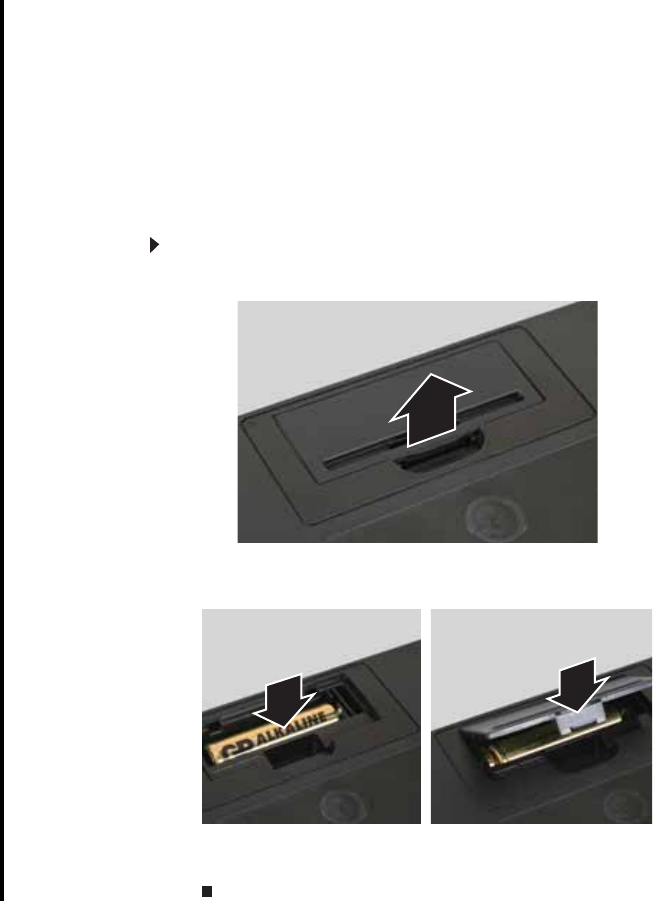
CHAPTER2: Setting Up and Getting Started
16
Using the keyboard and mouse
Using the keyboard
Installing batteries
Before using your keyboard, you must install the two batteries
that came with your computer.
To install the keyboard batteries:
1Turn the keyboard over, then open the battery cover.
2Insert two AA batteries according to the diagram inside
the battery compartment, then close the battery cover.
3Re-sync the keyboard by following the instructions in
“Syncing the keyboard and mouse” on page 21.
8512563.book Page 16 Wednesday, August 15, 2007 2:30 PM
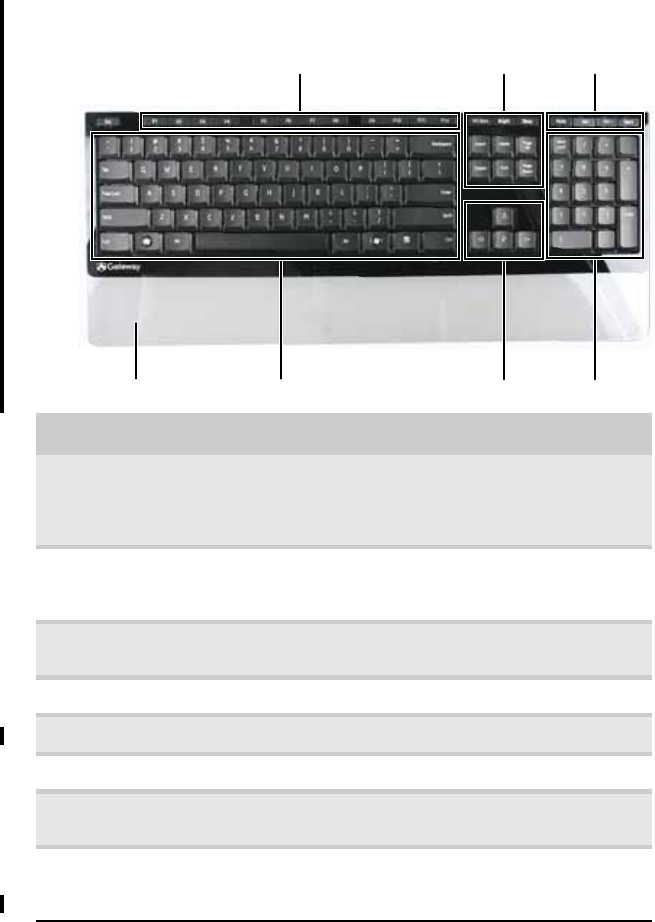
www.gateway.com
17
Using the keyboard
Feature Description
Function keys Press these keys to start program actions. Each program uses
different function keys for different purposes. See the
program documentation to find out more about the function
key actions.
Navigation keys Press these keys to move the cursor to the beginning of a
line, to the end of a line, up the page, down the page, to the
beginning of a document, or to the end of a document.
Multimedia
controls Press these keys to play your audio files and to adjust the
volume.
Wrist rest While typing, you can rest your wrist on this acrylic surface.
Main keyboard Press these keys to type numbers, letters, and to format text.
Directional keys Press these keys to move the cursor up, down, right, or left.
Numeric keypad Press these keys to type numbers when the numeric keypad
(NUM LOCK) is turned on.
Indicators Show if your NUM LOCK, CAPS LOCK, or SCROLL LOCK keys are
activated. Press the corresponding key to activate the
function.
Function keys Navigation keys
Main keyboard Directional keys Numeric keypad
Multimedia controls
Wrist rest
8512563.book Page 17 Wednesday, August 15, 2007 2:30 PM
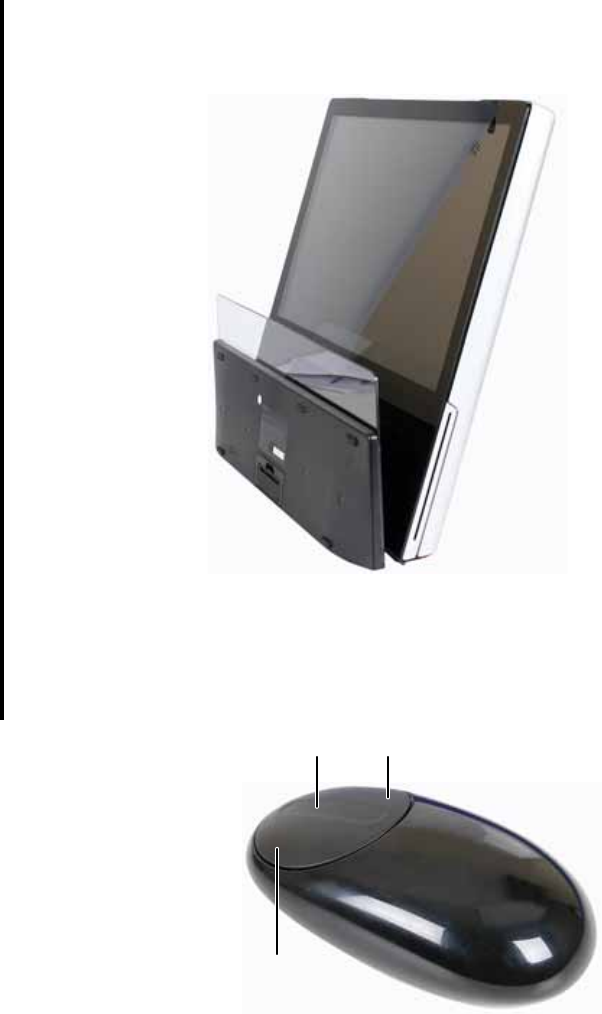
CHAPTER2: Setting Up and Getting Started
18
Storing your keyboard
You can move your keyboard out of the way by standing it
upright and sliding it against your computer.
Using the mouse
Mouse components
Scroll stripe
(functions as a scroll wheel)
Left button
Right button
8512563.book Page 18 Wednesday, August 15, 2007 2:30 PM
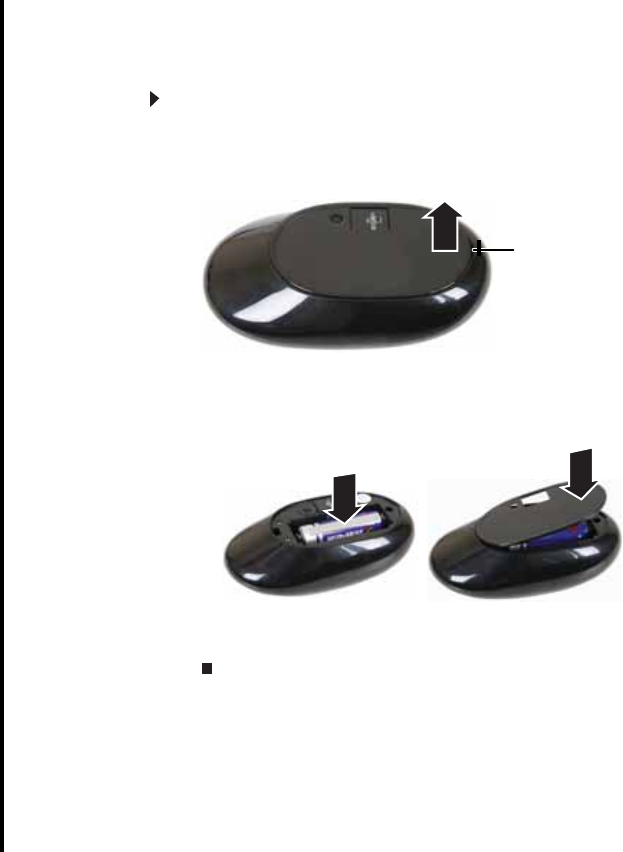
www.gateway.com
19
Installing batteries
Before using your mouse, you must install the two batteries
that came with your computer.
To install the mouse batteries:
1Turn the mouse over, then remove the battery cover by
prying it up using a thin, stiff object (such as your
fingernail).
2Insert two AA batteries according to the diagram inside
the battery compartment, then replace the battery
cover.
3Re-sync the mouse by following the instructions in
“Syncing the keyboard and mouse” on page 21.
Controlling the mouse
The mouse is a device that controls the pointer movement on
the computer display. This illustration shows the standard
mouse.
As you move the mouse, the pointer (arrow) on the display
moves in the same direction.
Pry up here
8512563.book Page 19 Wednesday, August 15, 2007 2:30 PM
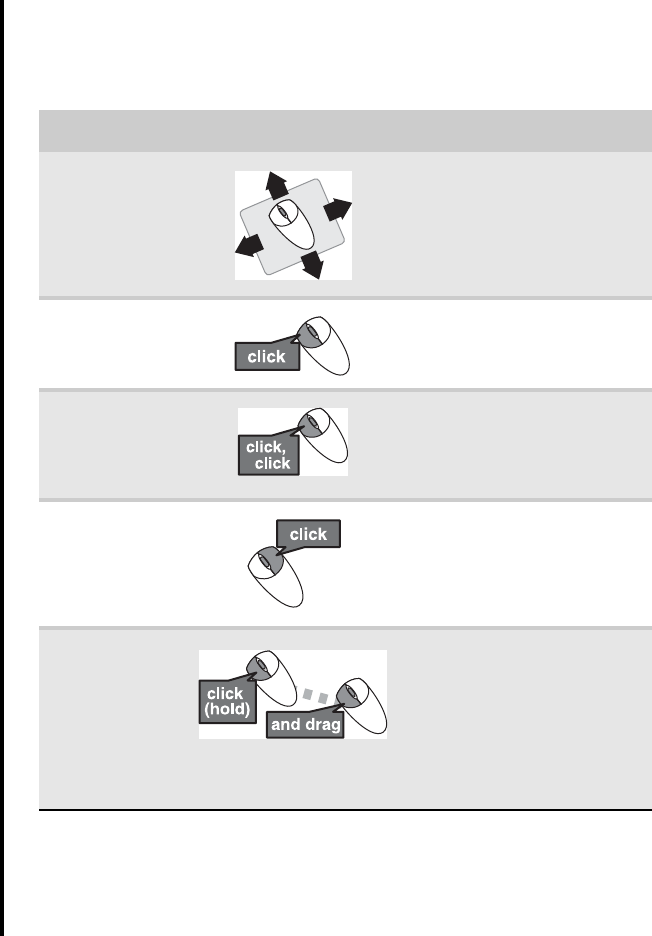
CHAPTER2: Setting Up and Getting Started
20
You can use the left and right buttons on the mouse to select
objects on the display. You can use the scroll stripe (the stripe
between the left and right mouse buttons) on the mouse to
move through a document. This feature is not available in all
programs.
For more information about how to adjust the double-click
speed, pointer speed, right-hand or left-hand configuration,
and other mouse settings, see the “Customizing” chapter in
your online User Guide. For instructions on how to clean the
mouse, see “Cleaning the mouse” on page 61.
To... Do this...
Move the pointer
on the computer
display
Move the mouse around. If you
reach the edge of your mouse
pad and need to move the
mouse farther, lift the mouse
and place it in the middle of the
mouse pad, then continue
moving the mouse.
Select an object
on the computer
display
Position the pointer over the
object. Quickly press and
release the left mouse button.
This is called clicking.
Start a program
or open a file or
folder
Position the pointer over the
object. Quickly press and
release the left mouse button
twice. This is called
double-clicking.
Access a
shortcut menu
or find more
information
about an object
on the display.
Position the pointer over the
object. Quickly press and
release the right mouse button
once. This is called
right-clicking.
Move an object
on the computer
display.
Position the pointer over the
object. Press the left mouse
button and hold it down. Move
(drag) the object to the
appropriate part of the
computer display. Release the
button to drop the object
where you want it. This is called
clicking and dragging.
8512563.book Page 20 Wednesday, August 15, 2007 2:30 PM
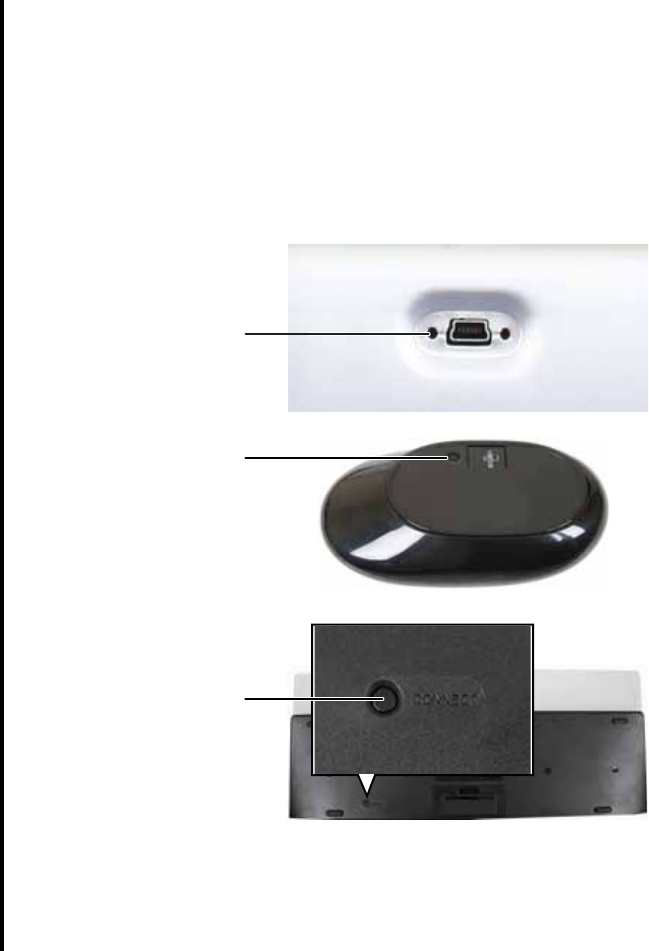
www.gateway.com
21
Syncing the keyboard and mouse
Your wireless keyboard and mouse are synced with your
computer at the factory. If for some reason the computer does
not seem to be able to detect the mouse and keyboard, try the
following:
•Insert a stiff wire (such as a straightened paper clip) into
the wireless sync button hole on the top of your
computer (to the left of the Web cam’s mini USB port),
then press the sync button on the bottom of your mouse
and keyboard.
•Press the power button. Your computer restarts, and
your keyboard and mouse re-synchronize.
•Replace the batteries with new ones, then re-sync the
mouse and keyboard. For instructions on changing
batteries, see “Changing keyboard batteries” on page 56
and “Changing mouse batteries” on page 57.
Sync button
(mouse)
Sync button
(computer)
Sync button
(mouse)
8512563.book Page 21 Wednesday, August 15, 2007 2:30 PM
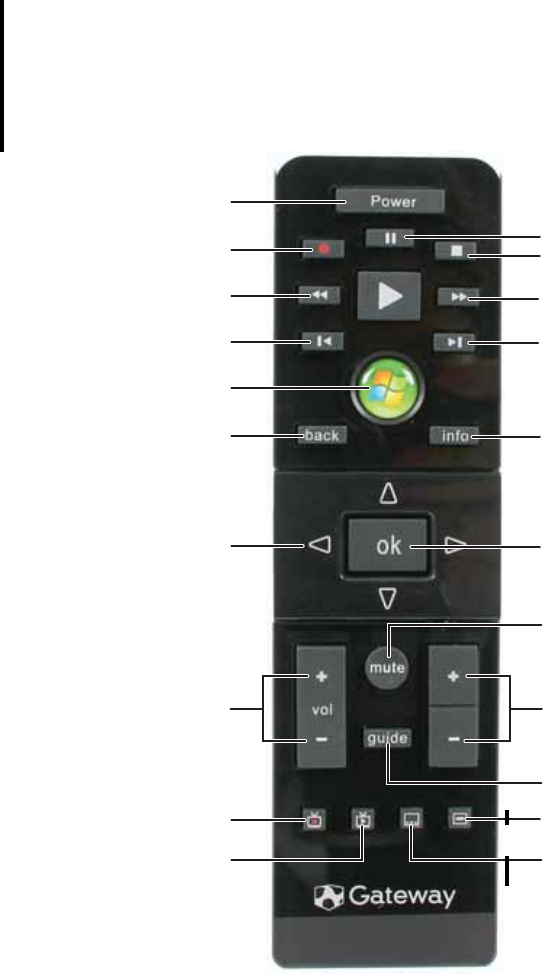
www.gateway.com
25
Using the remote control
The Media Center remote control is an optional accessory. Your
Media Center remote control lets you record and play back
media on your computer. It also lets you turn your computer
on and off.
Power
Record
Rewind
Skip to previous
Media Center mode
Back
Menu navigation
Volume
Record from video
input
Play from video
input
Pause
Stop
Fast forward
Skip to next
Info
Select
Channel
CD/DVD mode
Closed Captions and
subtitles
Mute
Program guide
8512563.book Page 25 Wednesday, August 15, 2007 2:30 PM
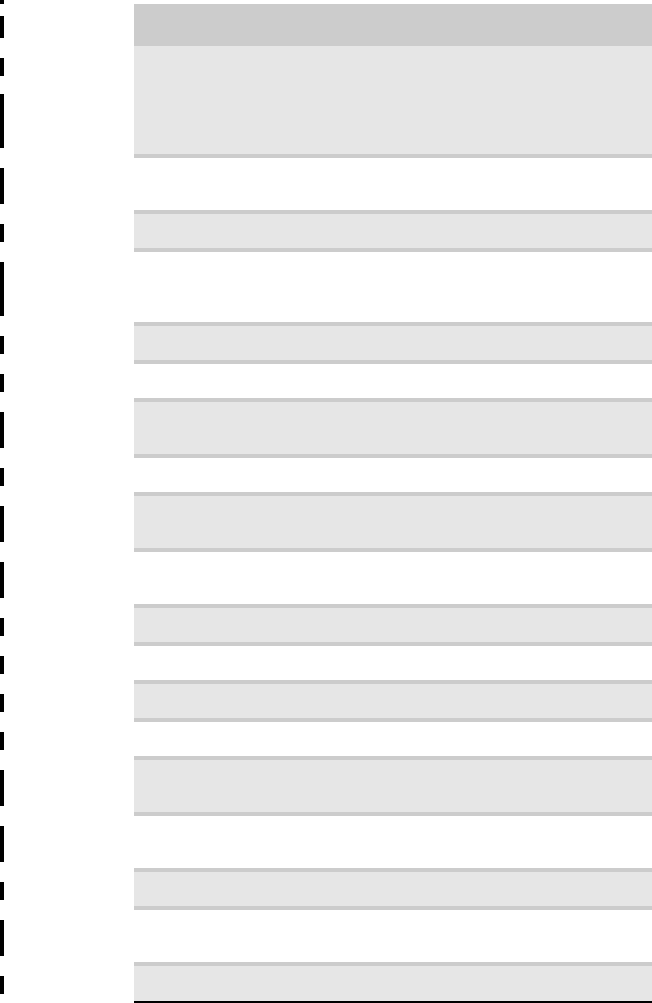
CHAPTER2: Setting Up and Getting Started
26
Button Description
Power Turns the computer on and off. [or is it
supposed to turn on/off a component, as a
universal remote control? If this is a
universal/programmable remote, do we
need to include programming codes?]
Record Press for one-touch recording of the
currently selected video source.
Rewind Rewinds the currently playing media.
Skip to previous Skips to the start of the currently playing
track or chapter, then skips to the previous
track or chapter.
Media Center mode Opens Windows Vista’s Media Center mode.
Back In a setup menu, goes back one menu level.
Menu navigation Moves up, down, left, and right through
menus and settings.
Volume Changes volume.
Record from video
input Records from the currently selected video
source. [Is this like DVR recording?]
Play from video input [--can anyone explain what this does? This
label was just a guess]
Pause Pauses the currently playing media.
Stop Stops the currently playing media.
Fast forward Fast forwards the currently playing media.
Skip to next Skips to the next track or chapter.
Info Displays the current track or chapter
information.
Select Selects the currently highlighted menu
item.
Mute Mutes all sound.
Program guide Opens the program guide, where you can
select programs to watch and record.
Channel Changes channel.
8512563.book Page 26 Wednesday, August 15, 2007 2:30 PM
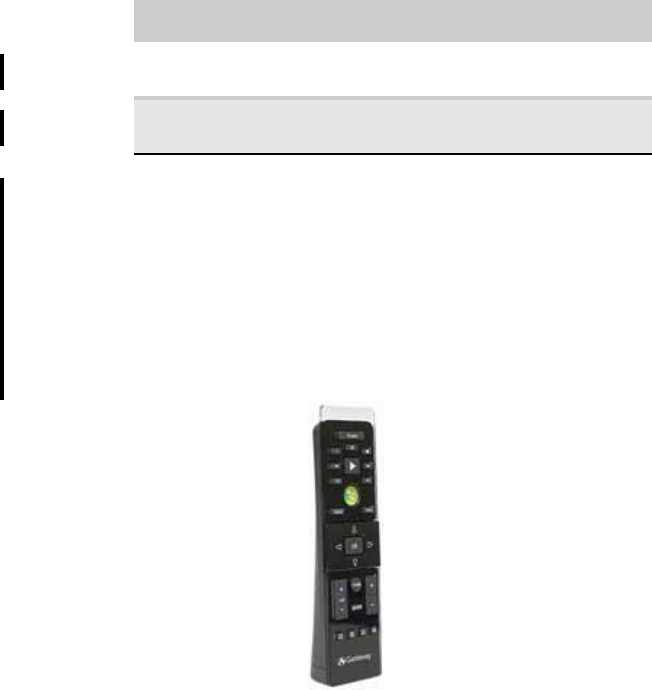
www.gateway.com
27
If your remote stops working, try the following:
•Restart your computer.
•Replace its batteries with new ones. For directions, see
“Changing remote control batteries” on page58.
Storing the remote control
Your remote control is designed so that you can store it
upright, taking up less desk space.
CD/DVD mode Plays the CD or DVD that is currently loaded
in the drive.
Closed Captions and
subtitles Turns Closed Captioning and subtitle on and
off.
Button Description
8512563.book Page 27 Wednesday, August 15, 2007 2:30 PM

www.gateway.com
109
Care during use
•
Do not walk on the power cord or allow anything to rest on it.
•
Do not spill anything on the system. The best way to avoid spills is to avoid eating and
drinking near your system.
•
Some products have a replaceable CMOS battery on the system board. There is a danger
of explosion if the CMOS battery is replaced incorrectly. Replace the battery with the
same or equivalent type recommended by the manufacturer. Dispose of batteries
according to the manufacturer’s instructions.
•
When the computer is turned off, a small amount of electrical current still flows through
the computer. To avoid electrical shock, always unplug all power cables and modem
cables from the wall outlets before cleaning the system.
•
Unplug the system from the wall outlet and refer servicing to qualified personnel if:
•
The power cord or plug is damaged.
•
Liquid has been spilled into the system.
•
The system does not operate properly when the operating instructions are followed.
•
The system was dropped or the cabinet is damaged.
•
The system performance changes.
Regulatory compliance
statements
United States of America
Federal Communications Commission (FCC)
Unintentional emitter per FCC Part 15
This device has been tested and found to comply with the limits for a ClassB digital device,
pursuant to Part15 of the FCC rules. These limits are designed to provide reasonable protection
against harmful interference in a residential installation. This equipment generates, uses, and can
radiate radio frequency energy and, if not installed and used in accordance with the instructions,
may cause harmful interference to radio or television reception. However, there is no guarantee
that interference will not occur in a particular installation. If this equipment does cause
interference to radio and television reception, which can be determined by turning the equipment
off and on, the user is encouraged to try to correct the interference by one or more of the following
measures:
•
Reorient or relocate the receiving antenna
•
Increase the separation between the equipment and receiver
•
Connect the equipment to an outlet on a different circuit from that to which the receiver
is connected
•
Consult the dealer or an experienced radio/TV technician for help.
Compliance accessories
: The accessories associated with this equipment are: shielded video
cable when an external monitor is connected. These accessories are required to be used in order
to ensure compliance with FCC rules.
Warning
Do not use Gateway products in areas classified as hazardous locations.
Such areas include patient care areas of medical and dental facilities,
oxygen-laden environments, or industrial facilities.
Warning
To reduce the risk of fire, use only No. 26 AWG or larger (for example, No.
24 AWG ) UL-listed or CSA-certified telecommunication line cord for your dialup
modem connection.
8512563.book Page 109 Wednesday, August 15, 2007 2:30 PM
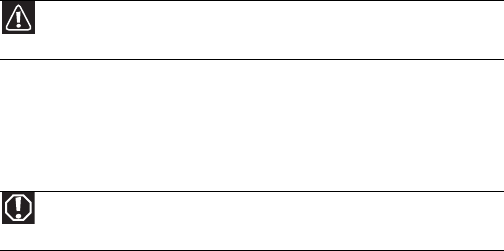
CHAPTER 1: Legal Notices
110
FCC declaration of conformity
Responsible party:
Gateway, Inc.
7565 Irvine Center Drive
Irvine, CA 92618
Phone: 800-846-2000
This device complies with Part 15 of the FCC Rules/RSS-210. Operation of this device is subject to
the following two conditions: (1)this device may not cause harmful interference, and (2) this device
must accept any interference received, including interference that may cause undesired operation.
California Proposition65 Warning
Telecommunications per Part68 of the Code of Federal
Regulations (CFR47) (applicable to products fitted with
USA modems)
Your modem complies with Part 68 of the Code of Federal Regulations (CFR47) rules. On the
computer or modem card is a label that contains the FCC registration number and Ringer
Equivalence Number (REN) for this device. If requested, this information must be provided to the
telephone company.
A telephone line cord with a modular plug is required for use with this device. The modem is
designed to be connected to the telephone network or premises wiring using a compatible
modular jack which is Part68-compliant. See installation instructions for details.
The Ringer Equivalence Number (REN) is used to determine the number of devices which may be
connected to the telephone line. Excessive RENs on a telephone line may result in the devices not
ringing in response to an incoming call. In most areas, the sum of RENs should not exceed five
(5.0). To be certain of the number of devices that may be connected to a line, as determined by
the total RENs, contact the local telephone company.
If this device causes harm to the telephone network, the telephone company will notify you in
advance that temporary discontinuance of service may be required. The telephone company may
request that you disconnect the equipment until the problem is resolved.
The telephone company may make changes in its facilities, equipment, operations, or procedures
that could affect the operation of this equipment. If this happens, the telephone company will
provide advance notice in order for you to make necessary modifications to maintain
uninterrupted service.
This equipment cannot be used on telephone company-provided coin service. Connection to party
line service is subject to state tariffs. Contact the state public utility commission or public service
commission for information.
When programming or making test calls to emergency numbers:
•
Remain on the line and briefly explain to the dispatcher the reason for the call.
•
Perform such activities in the off-peak hours such as early morning or late evenings.
The United States Telephone Consumer Protection Act of 1991 makes it unlawful for any person
to use a computer or other electronic device to send any message via a telephone fax machine
unless such message clearly contains, in a margin at the top or bottom of each transmitted page
or on the first page of the transmission, the date and time it is sent, an identification of the
business, other entity, or other individual sending the message, and the telephone number of the
sending machine or such business, other entity, or individual. Refer to your fax communication
software documentation for details on how to comply with the fax-branding requirement.
Caution
Changes or modifications not expressly approved by Gateway could void
the FCC compliance and negate your authority to operate the product.
Warning
This product contains chemicals, including lead, known to the State of
California to cause cancer, birth defects or reproductive harm.
8512563.book Page 110 Wednesday, August 15, 2007 2:30 PM

www.gateway.com
111
Canada
Industry Canada (IC) Unintentional emitter per ICES-003
This digital apparatus does not exceed the Class B limits for radio noise emissions from digital
apparatus as set out in the radio interference regulations of Industry Canada.
Le présent appareil numérique n’émet pas de bruits radioélectriques dépassant les limites
applicables aux appareils numériques de ClasseB prescrites dans le règlement sur le brouillage
radioélectrique édicté par Industrie Canada.
Telecommunications per Industry Canada CS-03 (for
products fitted with an IC-compliant modem)
The Industry Canada label identifies certified equipment. This certification means that the
equipment meets certain telecommunications network protective, operation, and safety
requirements. The Department does not guarantee the equipment will operate to the users’
satisfaction.
Before installing this equipment, users should make sure that it is permissible to be connected to
the facilities of the local telecommunications company. The equipment must also be installed using
an acceptable method of connection. In some cases, the inside wiring associated with a single-line
individual service may be extended by means of a certified connector assembly. The customer
should be aware that compliance with the above conditions may not prevent degradation of
service in some situations.
Repairs to certified equipment should be made by an authorized Canadian maintenance facility
designated by the supplier. Any repairs or alterations made by the user to this equipment, or
equipment malfunctions, may give the telecommunications company cause to request the user
to disconnect the equipment.
Users should make sure, for their own protection, that the electrical ground connections of the
power utility, telephone lines, and internal metallic water pipe system, if present, are connected
together. This precaution may be particularly important in rural areas.
The
Ringer Equivalence Number
(REN) assigned to each terminal device provides an
indication of the maximum number of terminals allowed to be connected to a telephone interface.
The termination on an interface may consist of any combination of devices subject only to the
requirement that the sum of the Ringer Equivalence Numbers of all the devices does not exceed 5.
Laser safety statement
All Gateway systems equipped with CD and DVD drives comply with the appropriate safety
standards, including IEC 825. The laser devices in these components are classified as “Class 1 Laser
Products” under a US Department of Health and Human Services (DHHS) Radiation Performance
Standard. Should the unit ever need servicing, contact an authorized service location.
Warning
To avoid electrical shock or equipment malfunction do not attempt to
make electrical ground connections by yourself. Contact the appropriate
inspection authority or an electrician, as appropriate.
Warning
Use of controls or adjustments or performance of procedures other than
those specified in this manual may result in hazardous radiation exposure. To
prevent exposure to laser beams, do not try to open the enclosure of a CD or DVD
drive.
8512563.book Page 111 Wednesday, August 15, 2007 2:30 PM